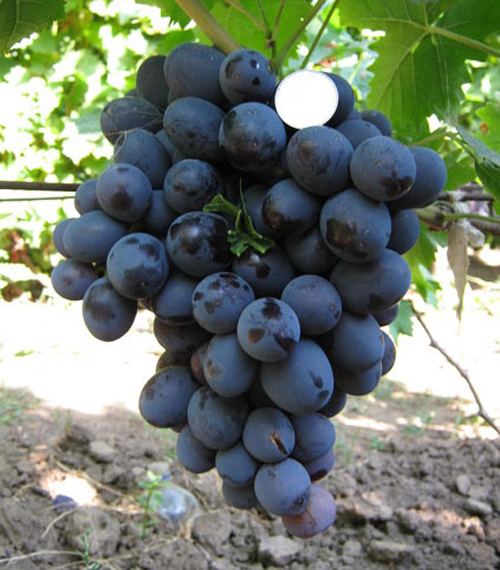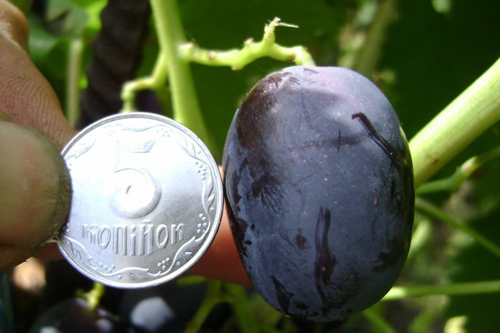Grape variety Mercedes (Hadji Murat)
Hadji Murat is a high-quality, very large-fruited hybrid form of popular grape selection originally from Tajikistan. By its place of origin, it is often called "Tajikistan", and in neighboring Uzbekistan, the popular name Mercedes was firmly entrenched in it, which also became its commercial name when exported from the country. Very little is known about the emergence of a hybrid. It is assumed that it originated from the pollination of the local Tyagobi variety with Pobeda pollen, bred at the Central Asian station of the VIR in 1944. Often, as the parental couple, Hadji Murat is mistakenly called Zabalkan and Muscat of Hamburg, which does not correspond to reality. The confusion arose due to the fact that these varieties are the maternal and paternal form of Victory, from which, in fact, our hero originated. Thus, these known varieties should not be considered parents, but the "grandmother" and "grandfather" of Mercedes.

As a result of the crossing, the new hybrid that appeared turned out to be rather unassuming in comparison with the traditional Central Asian varieties, but at the same time it differed little from them in terms of attractiveness of appearance, sophistication of taste and general attractiveness in the eyes of buyers. As a result, it began to spread rapidly throughout the region, and today it is produced in significant quantities both for local consumption and for export.
In recent years, the exotic variety has become popular among domestic winegrowers, gradually expanding the geography of distribution in the European part of our country. Moreover, in contrast to the ancient varieties of grapes of the eastern ecological-geographical group, Hadji Murat shows good plasticity and adaptability to atypical conditions for himself during the introduction, due to which he gradually builds up an army of sincere admirers here.
Agrobiological characteristics
Plants are highly vigorous. The crown of a young Mercedes shoot is shiny, without pubescence, green in color with reddish stripes on the axis of the shoot and a bronze tint of young leaves. The fully developed leaf is large, rounded, consists of five lobes with a weak degree of their dissection, painted in a rich green color. The upper side cutouts have a medium depth and a slit or reentrant shape. The lower notches are often absent or may be barely outlined. The petiole notch is open lyre-shaped, or vaulted, with a pointed bottom, sometimes with a "denticle" on the bottom. Petioles are of medium to above medium length, green, often with anthocyanin tones. The teeth along the edge of the vine leaf are predominantly triangular, unequal in size, have slightly curved edges and sharp tops. The flowers are bisexual, very well fertilized without the help of pollinators, forming very massive clusters without signs of pea berries. The scattering of flowers and ovary behind Hadji Murat was also not noticed. The growth of the current year is ripening well - up to 70-80% of its length, while acquiring a light brown color in internodes, with a darker shade in the area where the nodes are located.

Bunches of Mercedes grow in truly stunning sizes, up to 40 cm long and weighing up to 3 kg. At the same time, the average weight of brushes is in the range of 900-2000 grams, they are broadly conical in shape, branched, not too high density. The comb is very powerful, green, but sometimes lignified at the base. Due to the outstanding size of the grapes, the variety is considered one of the largest-fruited. In length, a slightly oval berry reaches a size of 40-50 mm, in diameter - 30-35 mm, while the mass can reach 20 or more grams. The color of the fruit is dark purple, close to black, the surface is covered with a dense layer of gray wax bloom.Due to the moderate looseness of the brushes, the grapes, despite their size, do not damage each other and do not undergo deformation. The pulp is dense, fleshy with a crunch characteristic of oriental varieties when chewed. The taste is pleasant, harmonious without harsh memorable tones in the aftertaste and aroma. The sugar content of the juice is not bad. Even under domestic conditions, grapes accumulate up to 18-19 g / 100 ml of sugars, and in Central Asia this figure is even higher. The titratable acidity at the time of the onset of removable maturity is about 5-6 g / l, and when fully ripened, it drops below. The skin of the berries is thin, but rather strong, it does not separate from the pulp, and it is felt weakly when eaten. There are few seeds in grapes, and in a giant volume of pulp they are not very noticeable. The grape tasting scores are quite high, their average value is 8.5 points.
The harvest of this variety is mostly used fresh. In the Central Asian republics, Mercedes is also in demand in the local market, and is exported in significant volumes abroad. The bunches and berries of outstanding size and taste leave no one indifferent, thanks to which the areas under this highly commercial hybrid are constantly growing, but the volumes of production are not keeping up with the demand. Hadji Murat's transportability is high; he covers considerable distances, measured in thousands of kilometers, without much damage. Keeping quality can be characterized as good, especially in the case of creating an optimal microclimate in the storage room.
Domestic farmers, especially in the south of the country, are also looking closely at the variety, since the high price for an unusual, but at the same time very “marketable” variety promises a high profitability of its cultivation. Do not lag behind and amateur winegrowers who grow "sunny berries" for themselves. For them, Mercedes is attractive for its oriental exoticism and at the same time its ability to grow in temperate climates. In addition to fresh consumption, grapes are successfully used to make delicious homemade preparations for the winter, and sometimes even processed into wine in their homeland.

Hadji Murat belongs to the group of varieties with an average ripening period. The growing season lasts 130-135 days, counting from the moment the buds open, up to the moment of maturity of the first brushes. In this case, the sum of active temperatures is also required to be moderate - 2700-2800 ° C. A similar level of heat supply is typical for the latitude of cities such as Saratov, Voronezh, Kursk and Chernigov, and this line, in principle, can be considered the northern border of the cultivation of Mercedes in the open field. It should be borne in mind that in these places, in the coldest seasons, without measures to increase the level of SAT, it may not mature enough. Another limiting factor is the low frost resistance of the variety, at the level of −19 ... −21 ° С. This circumstance, however, does not interfere with cultivating it, covering it for the winter wherever the grapes themselves have time to ripen.
Despite the eastern origin, which is often associated with low fruitfulness of shoots and the need to carry out long pruning in this regard, our Tajik hero does not differ at all with such shortcomings. Already the first eyes on the shoots of a Mercedes turn out to be fruitful, and their productivity is so high that it requires restrictions in the course of green operations. For this reason, the variety is prone to overload, although it is capable of "pulling" with good agricultural technology and powerful formation of up to 30-35 kilograms of grapes.
Long-term presence of the crop on plants after ripening is practiced in the countries of Central Asia with their dry climate and water regime of the soil controlled by irrigation. However, in our country, Hadji Murat often demonstrates the cracking of berries, which occurs due to the abrupt change of dry periods with torrential rains. And the trouble, as you know, does not come alone: after the start of cracking, wasps en masse attack the grapes, which are not particularly interested in them, while the berries are whole.
Agrotechnical features
From an economic point of view, Mercedes, as already noted, shows itself in an order of magnitude more unassuming than traditional oriental varieties. But at the same time, for active development and rich stable fruiting, without harming the plants themselves, it requires the fulfillment of certain conditions of the cultivation technology.
For placement, he prefers the warmest places on the slopes of the southern exposures, or in the near-wall culture - on the southern side of various buildings that protect the grapes from the cold northern winds. Any lowlands, cold slopes, and even open flat areas are categorically unsuitable for planting, when it comes to regions where there is a risk of insufficient harvest ripening. Soils Hadji Murat prefers alkaline calcareous, or, in extreme cases, neutral pH. On acidic soil, as well as on saline, as well as in damp and wetlands, Mercedes develops inhibited.
The variety can be propagated by cuttings, thanks to their rather easy rooting. However, this method is possible only where the soil is not infected with a dangerous pest of grapes - root phylloxera. If there is no guarantee that there will be no harmful root aphids in your area, then it is better to plant seedlings grafted onto phylloxera-resistant rootstocks. The feeding area for vigorous bushes should be allocated sufficient so that they do not oppress neighboring plants, and they themselves do not waste energy fighting for a place in the sun.
Shelter Mercedes for the winter in domestic conditions is necessary almost everywhere. Only in the very south, where there is no likelihood of severe frost damage to the Tajik guest, can you try to form standard non-covering bushes, which, by the way, allow the hybrid to fully reveal its capabilities. In the rest of the grape-growing areas, covering formations are practiced, the most popular of which are the inclined cordon and the multi-arm fan.
Spring pruning and subsequent operations for rationing the yield of the variety should be carried out according to schemes unusual for oriental varieties. For Hadji Murat, medium and even strong shortening of fruit arrows, leaving 4-8 eyes on them, is suitable. In this case, the total load on the bush is 30-35 buds, followed by a fragment of weak and sterile shoots. On the fertile vines of the Mercedes, only one bunch is left.
The fight against diseases must be carried out fully and thoroughly due to the low resistance of our hero to fungal pathogens. To prevent cracking of berries, or at least reduce the scale of this phenomenon, you can use regular watering during dry periods, or mulching the soil with materials intended for this.
If these minimum requirements are met, Hadji Murat, in a southern way, will generously endow you with magnificent grapes of excellent taste.








